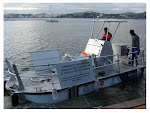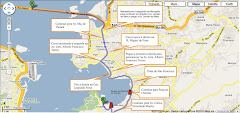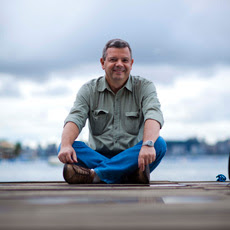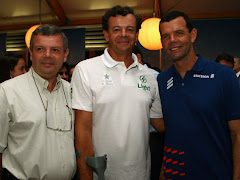Graças à excelente iniciativa voluntária do amigo Ronald Hees, da organização Companheiros das Americas/Comitê Rio de Janeiro-Maryland, nosso artigo na Coluna Rumo Náutico, do Jornal O Fluminense, publicada em 10 de abril de 2010, teve o seu conteúdo traduzido para o inglês.
----------------
Translation
Article by Axel Grael in his weekly (Saturdays) column in O Fluminense, April 10, 2010.
One Week of Nightmare
During the remote years of 1893-1894 Niteroi was shelled by navy boats in Guanabara Bay which had rebelled against the government of the just created Republic, as part of the navy´s revolt. Several districts were destroyed and thousands of people were killed or injured. Now, 126 years later we see the City being strongly destroyed again. Why should we remember this now? Because on both occasions destruction came by the hands of man. This time it were not the bombs but the lack of capacity of the public administration to coordinate the use of soil, the lack of housing which pushes the population in the direction of risk areas as well as the demagogic action of politicians who encourage the occupation of these areas. What about nature? According to some sources, this would have been the most intense rainfall in the history of Rio de Janeiro, but we can not blame nature. Torrential rains always occurred but we missed, along centuries of existence of our City, the capacity to learn how to live with its recurrent presence. And the situation may get worse. According to the warning of scientists, climate changes (which have anthropic origins) will make extreme climate events like the one we are experiencing now, be more and more frequent. Thus, it is not possible that the city continues to be administered as it has been. It is necessary to control the occupation of hill sides, remove people from the risk areas and return hill sides to their real vocation: to be protected areas.
I will always remember a remarkable attitude of the Niterói administration with respect to the question of the use of soil: in the 1982 electoral campaign, when Waldenir Bragança was elected Mayor of Niterói, I was the president of an environmental organization in the city (Ecological Resistance Movement – MORE). I organized a debate among the candidates to run the city. On the occasion, one of the candidates, answering a question related to “clearance patterns for buildings” (maximum height for buildings) stated: “this should be a matter to be ruled on by the Air Force”. In other words, in accordance with the illustrious candidate, as long as airplanes could fly over the city it was OK. To our luck the particular candidate was not elected, but his conception of city administration seems to have progressed. Niterói became vertical both on the asphalt streets as well as on the hills. We must recognize that there has to be a limit to the city growth, a limit set by the infrastructure and by the vocation of each space. This is not what we see in Niterói. Without investing in transportation infrastructure and other basic needs, the city has been conniving with the ambitions of the real estate sector and has allowed that each neighborhood be gradually taken over by the high-rises. At the same time, there is no action whatsoever to control the occupation of hill sides. Thus, what we see is only a regrettable announced tragedy. And the event at Bumba Hill, the risk of which had been alerted by specialists seems to be the summary of the problem: the occupation by a low income community on top of a garbage dump created by the public administration itself, and which, after applying the same practice to Morro do Céu (another major garbage dump of Niterói) simply abandoned the place and its population to their own (and bad) luck. By the way, doesn´t it seem an irony that the places picked for creating garbage dumps do always have bucolic names such as Heavens´ Hill (Morro do Céu), Exuberant Garden (Viçoso Jardim), Gramacho Gardens (Jardim Gramacho), etc?
Article by Axel Grael in his weekly (Saturdays) column in O Fluminense, April 10, 2010.
One Week of Nightmare
During the remote years of 1893-1894 Niteroi was shelled by navy boats in Guanabara Bay which had rebelled against the government of the just created Republic, as part of the navy´s revolt. Several districts were destroyed and thousands of people were killed or injured. Now, 126 years later we see the City being strongly destroyed again. Why should we remember this now? Because on both occasions destruction came by the hands of man. This time it were not the bombs but the lack of capacity of the public administration to coordinate the use of soil, the lack of housing which pushes the population in the direction of risk areas as well as the demagogic action of politicians who encourage the occupation of these areas. What about nature? According to some sources, this would have been the most intense rainfall in the history of Rio de Janeiro, but we can not blame nature. Torrential rains always occurred but we missed, along centuries of existence of our City, the capacity to learn how to live with its recurrent presence. And the situation may get worse. According to the warning of scientists, climate changes (which have anthropic origins) will make extreme climate events like the one we are experiencing now, be more and more frequent. Thus, it is not possible that the city continues to be administered as it has been. It is necessary to control the occupation of hill sides, remove people from the risk areas and return hill sides to their real vocation: to be protected areas.
I will always remember a remarkable attitude of the Niterói administration with respect to the question of the use of soil: in the 1982 electoral campaign, when Waldenir Bragança was elected Mayor of Niterói, I was the president of an environmental organization in the city (Ecological Resistance Movement – MORE). I organized a debate among the candidates to run the city. On the occasion, one of the candidates, answering a question related to “clearance patterns for buildings” (maximum height for buildings) stated: “this should be a matter to be ruled on by the Air Force”. In other words, in accordance with the illustrious candidate, as long as airplanes could fly over the city it was OK. To our luck the particular candidate was not elected, but his conception of city administration seems to have progressed. Niterói became vertical both on the asphalt streets as well as on the hills. We must recognize that there has to be a limit to the city growth, a limit set by the infrastructure and by the vocation of each space. This is not what we see in Niterói. Without investing in transportation infrastructure and other basic needs, the city has been conniving with the ambitions of the real estate sector and has allowed that each neighborhood be gradually taken over by the high-rises. At the same time, there is no action whatsoever to control the occupation of hill sides. Thus, what we see is only a regrettable announced tragedy. And the event at Bumba Hill, the risk of which had been alerted by specialists seems to be the summary of the problem: the occupation by a low income community on top of a garbage dump created by the public administration itself, and which, after applying the same practice to Morro do Céu (another major garbage dump of Niterói) simply abandoned the place and its population to their own (and bad) luck. By the way, doesn´t it seem an irony that the places picked for creating garbage dumps do always have bucolic names such as Heavens´ Hill (Morro do Céu), Exuberant Garden (Viçoso Jardim), Gramacho Gardens (Jardim Gramacho), etc?






















Nenhum comentário:
Postar um comentário
Contribua. Deixe aqui a sua crítica, comentário ou complementação ao conteúdo da mensagem postada no Blog do Axel Grael. Obrigado.